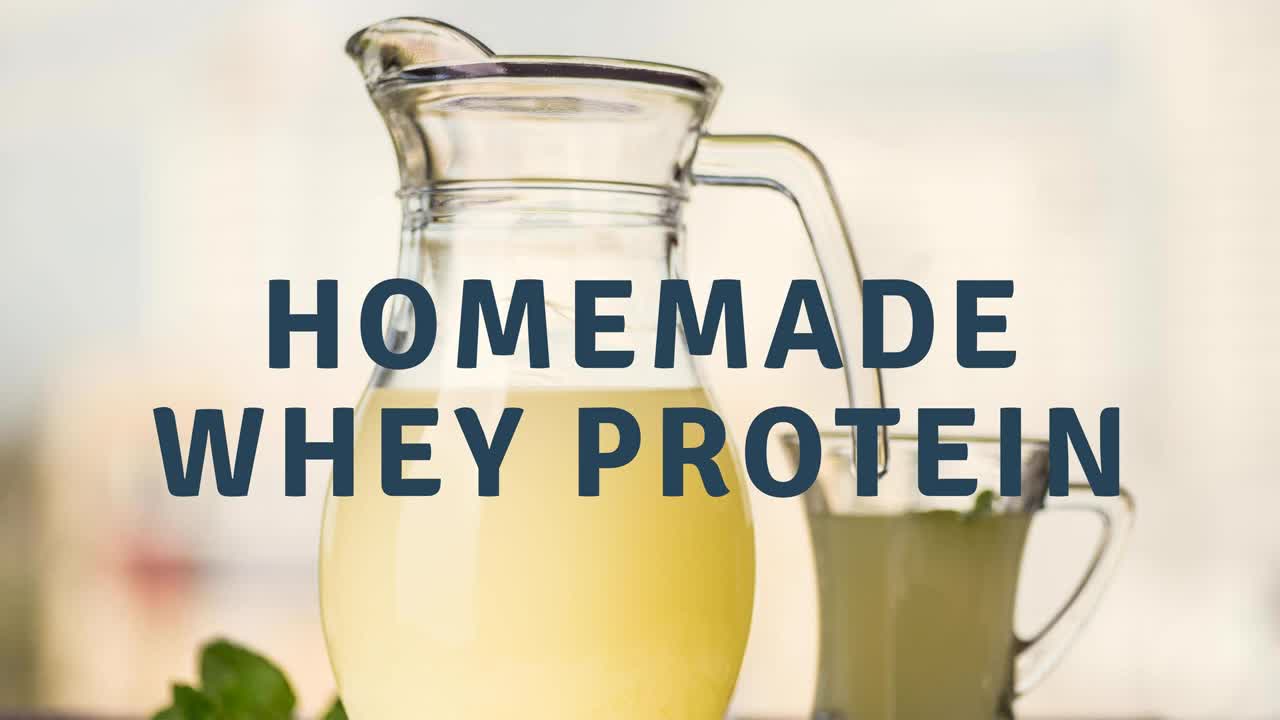Premium Only Content

Homemade Whey Protein
Today I’m talking all about homemade whey protein. What it is, how it might benefit your health, and how you might use it. Whey protein is a traditional food that has sustained humanity since the milking of domesticated animals began about 9,000 bc.
Before I get to far into today’s topic, as always, I want to take a minute to say welcome to all my new listeners and welcome back to the veteran homestead-loving regulars. Thank you so much for stopping by the FarmCast every week. I appreciate you all so much. I can’t wait to get to today’s topic. It has been whey too long in making it to the top of the list of topics.
Today’s Show
• Homestead Life Updates
• Homemade Whey Protein
• Chocolate Peanut Butter Protein Shake
Homestead Life Updates
There is never a dull moment.
Cows
Can you believe it? We are going to have another calf. I don’t really know when, I just know a very pregnant cow when I see one. We were sure Cloud was not going to have a calf. After all, the other calves were all born in April and May. Egwene, the jersey calf, was the last born and that was May 11th. Here we are five months later, possibly six months before the calf is born, getting ready for another calf to be born. We haven’t had a fall calf in some time. It will be yet another learning experience on the homestead.
I think it is time for the bull to go back to play with the other two bulls in the front field. This is the normal way to control when calves are born. The cow can’t get pregnant five or six months after everyone else if there is no bull there to impregnate her. It is a common practice to control calving season to remove the bull after two months or so. We have let it go on for three. Just when you think you have the thing of managing your livestock down pat and there can be no more to learn, you realize there is always more to learn.
Quail
The quail aren’t laying very many eggs at this point. They are eating and not producing. The most likely issue is the reduction of the amount of light. They need about 14 hours of light to consistently produce nearly an egg every day. Without that, we are lucky to get an egg once a week. There are artificial lights that we can install so they will be able to make their eggs regularly. However, that would require taking time away from other tasks to make it happen.
Creamery
Amidst all the animal husbandry, Scott is moving forward with the creamery. He is racing the season to get all of the blocks in place while it is still warm enough for the cement and/or mortar to set up properly. Along the way, the wood for winter heat is not be cut. He feels these tasks weighing on him. There is always more to do than hours to accomplish it. However, it will all get done in the end.
Sometimes I think we make ourselves worry just for the exhilaration of having stress and pressure. Sounds crazy, right? Why would anyone intentionally create stress in their lives. Well, I’m not saying we intentionally create stress in our lives. Life is very stressful all on its own. But I am saying that sometimes we create additional stress that is unnecessary. And I am speaking for myself here. There is a compulsive way of thinking that permeates my brain sometimes that is unhealthy in regards to stress. I find myself thinking, “I have to do this” and “I have to do that” and “it has to be done by this time or that time” or else . . . or else what? What disaster is it that will happen if I get the laundry done a day later than I had on my schedule. How will my world come crumbling down around me if I plan to cook a great dinner and end up too tired to pull it off. We will still eat – and we will eat well. It’s crazy. Do you ever have thoughts like that?
When I catch myself thinking that way, I stop and take a deep breath and remind myself that all is well in this moment. I get out of my head and come back to my body and look around me. I see the sunshine. I smell the fresh air. I feel the cool breeze on my face. I hear the animals all doing their thing. The donkeys are braying. The geese are honking. The cows are mooing. The sheep and goats are baaing. I have to slow down and smell the roses every once in a while. Being in the present moment brings peace in a chaotic world. In fact, the chaos disappears in the present moment.
Now that you have some great ideas about bringing peace into your lives, let me move on to adding some sound nutrition information. It has to do with adding protein to your diet via whey.
Homemade Whey Protein
As I said, today I’m talking all about whey protein. But not that powdered stuff you buy at Walmart. No, I’m talking about traditional homemade whey protein. What it is, how it might benefit your health, and how you might use it in your healthy diet.
What is whey? Remember the nursery rhyme describing Little Miss Muffet eating her curds and whey? Have you seen the body-building enthusiasts with their plastic containers of whey protein shakes? What about the diet gurus and their protein shakes? Whey is the health food at the center of each. Some people talk about liquid whey. Some are talking about whey in the form of powders, hydrolysates, isolates or concentrates; there is sweet whey, acid whey, chocolate whey, strawberry whey, goat whey, mineral whey...it is all very exciting! So, in the midst of all this whey hype, how about looking at what real whey is? That wonderful, nutritious, whole food that has been consumed by traditional cultures for thousands of years.
Traditional Dairy Culture
Most people today think of dairy as plain, white, unfermented milk. Remember the commercial, “Got Milk?” with someone sporting a white mustache after drinking a tall glass of the cold creamy stuff. This has not always been the case. Before the industrialized practices of refrigeration and pasteurization became commonplace, many people enjoyed their milk products soured or fermented in the forms of yogurt, cheese, kefir, clabber, creme fraiche, or curds and whey. I’ve discussed most of these products in previous episodes.
When left out to sour or when cultured with friendly lactic-acid-producing bacteria, raw milk undergoes a process of fermentation wherein the bacteria start to digest or break down the milk sugars (lactose) and milk proteins (casein).Through this process, there is a natural separation of firm white globs of curds from the liquid whey portion of the milk. These white curds are the casein-containing portion of the milk, which are further fermented and processed into cheeses. The remaining tart liquid is whey.
Commercial Whey Protein
Whey has been used in traditional cuisine for centuries, and was known by Greek doctors as “healing water” for its strength-building properties. Today however, whey is considered a waste product of the cheese and yogurt industries. Many small cheese makers struggle with what to do with it. The wildly popular Greek yogurt industry makes a lot of whey. Plain yogurt contains all of the whey from the milk, but the thickness of Greek yogurt is achieved by straining out some of the whey. The larger Greek yogurt producers have been under scrutiny from environmental agencies for the gallons upon gallons of “whey waste” that they must get rid of after processing their strained yogurt products. For every four pounds of milk, only one pound of Greek yogurt is made, and the rest is a mixture of whey, chemicals and other acidic byproducts.
The cheese and yogurt industries drowning in whey scrambled to figure out just what to do with all of this tangy liquid. They found an outlet in the sports nutrition industry where leftover whey is being powdered, flavored and marketed as a muscle-building, energy-boosting supplement. Sounds like a very solid plan, except for the fact that the whey from big industry is truly waste. The milk is exposed to high heat pasteurization and subject to several acid baths. Any potentially beneficial nutrients are obliterated and mingled with nasty toxins during production.
Supplement companies have tried to “purify” their products by isolating different parts of the protein portion of the whey. So you get many different formulations on the market such as isolates, hydrosylates, concentrates, etc. This additional fractioning subjects the already destroyed whey to even more sketchy chemical processes and eliminates co-factors, rendering any possible remaining nutrients completely un-bioavailable. So despite the luring claims on those big black tubs of peanut-butter chocolate whey protein, these commercial powders are questionable as to their ability to help your body get stronger.
Traditional Whey Protein Nutrition
When made properly in small batches from cultured dairy, whey has incredibly unique healing properties. Rich with biologically active proteins and protein fractions, it has a high concentration of essential amino acids that are readily used to support vital biological functions in the body. Among these beneficial factors is:
• Lactoferrin, a multifunctional protein with iron-binding properties that acts as a powerful antimicrobial and anti-inflammatory
• Bovine serum albumin (BSA), a substance high in amino acids that has been shown to support infection-fighting white blood cells, increase antioxidant activity and maintain healthy cholesterol levels in the body
• Immunoglobulins to support disease control by bolstering immunity
• Probiotic organisms to promote optimal digestion and full nutrient absorption by balancing the gut flora
• Essential amino acids in a highly bioavailable form to act as building blocks for proteins
• Glutathione precursors, to boost production of the body's most powerful antioxidant
• Minerals such as potassium, iron and zinc are available in balanced amounts
• Vitamins notably vitamin B2 or riboflavin which helps the body to convert carbohydrates into fuel
How much protein is there in homemade whey protein?
1/2 cup = 15 grams.
1 cup = 30 grams.
If you are interested in obtaining homemade whey, let me know. As cheesemakers, we have lots of it. Most of it will go to our animals, supplementing their protein needs, but there will still be plenty for your needs should you request it.
Homemade whey has many uses including making lacto-fermented vegetables, condiments or beverages; soaking and sprouting nuts or grains; or as an additive to smoothies, sauces and stocks.
It’s no surprise that today’s recipe uses homemade whey protein. Let’s get to it.
Chocolate Peanut Butter Protein Shake
There are tons of protein shake recipes out there, but if you love that chocolate and peanut butter combo, a chocolate peanut butter protein shake is a great way to curb the craving without reaching for the cookies or peanut butter cups.
This chocolate peanut butter protein shake can be whipped up in your blender or smoothie maker in no time. It is packed with protein to keep you full, satisfied, and healthy.
What You Need
• 2 tablespoons peanut butter
• 1 banana
• 1 cup homemade whey protein
• 1 cup whole milk
• 1 tablespoon honey (optional)
What To Do
1. Blend all ingredients for 30 seconds
2. Serve
Nutritional Facts
• Calories, 465
• Protein, 43 g
• Carbohydrates, 39 g
• Fats, 17 g
Final Thoughts
I trust your life is filled with activities and that you remember to stop and smell the roses occasionally. This is an absolutely beautiful time of year. Take the time to let it seep into your bones and your being. Your health is your greatest asset.
Homemade whey can be a part of your healthy diet. It’s a traditional food that strengthened our ancestors and ensured our survival – then and now.
Let me know how that whey protein shake works for you. What variations did you try? Drop me an email, or better yet, comment below the show notes.
If you enjoyed this podcast, please hop over to Apple Podcasts, SUBSCRIBE and give me a 5-star rating and review. Tell everyone how wonderful homemade whey protein is. And the best thing you can do for my podcast is to share it with any friends or family who might be interested in this type of content.
As always, I’m here to help you “taste the traditional touch.”
Thank you so much for stopping by the homestead and until next time, may God fill your life with grace and peace.
Recipe Link
Chocolate Peanut Butter Protein Shake
To share your thoughts:
• Leave a comment on our Facebook Page
• Share this show on Twitter, Facebook and Instagram
To help the show:
• PLEASE LEAVE A REVIEW for Peaceful Heart FarmCast on Apple Podcasts.
• Subscribe on iTunes, Stitcher Radio, Google Play Music, TuneIn or Spotify
• Donate on Patreon
Website
www.peacefulheartfarm.com
Patreon
www.patreon.com/peacefulheartfarm
Facebook
www.facebook.com/peacefulheartfarm
Instagram
www.instagram.com/peacefulheartfarm/
-
 LIVE
LIVE
Slightly Offensive
2 hours agoTop Secret CIA Docs LEAKED Showing the Austrian Painter SURVIVED | Nightly Offensive
698 watching -
 15:53
15:53
Producer Michael
5 hours agoWHY I MOVED TO LAS VEGAS! (CALIFORNIA IS DOOMED)
43 -
 LIVE
LIVE
Adam Does Movies
7 hours agoHanging Out, Talking Movies + YouTube Silver Play Button Unboxing! - LIVE!
19 watching -
 1:22:50
1:22:50
Glenn Greenwald
4 hours agoRight-Wing Populists Barred from Running in Democratic World; JFK Reporter Jeff Morley on CIA Involvement and his Testimony in Congress Today | SYSTEM UPDATE #432
73.2K28 -
 58:27
58:27
BonginoReport
4 hours agoMusk’s 13th Alleged Baby Mama’s Anti-Privacy Tour - Nightly Scroll w/Hayley Caronia (Ep.17)
105K39 -
 2:11:32
2:11:32
Michael Franzese
3 hours agoLindy Li: DNC Insider Reveals Dark Truth About Biden, Kamala and Pelosi
28.1K24 -
 1:17:20
1:17:20
Kim Iversen
5 hours agoFrom Tesla-Smashing to Jasmine Crockett-Stanning: Woke Unhinged Edition
100K54 -
 LIVE
LIVE
TheSchleppy
23 hours ago $0.24 earned✨TheSchleppy✨RYSE BEATIN 6HOURS-WUKONG TIME! A 24HOUR STREAM?
51 watching -
 LIVE
LIVE
ManoloCalifas
55 minutes ago🔴 LIVE - LAST STREAM BEFORE VERDANSK IS OUT | GRINDING TO 100 FOLLOWS
19 watching -
 1:34:17
1:34:17
Redacted News
5 hours agoNetanyahu Boasts Control Over Trump: Is Criticizing Israel About to Become Illegal?
107K261